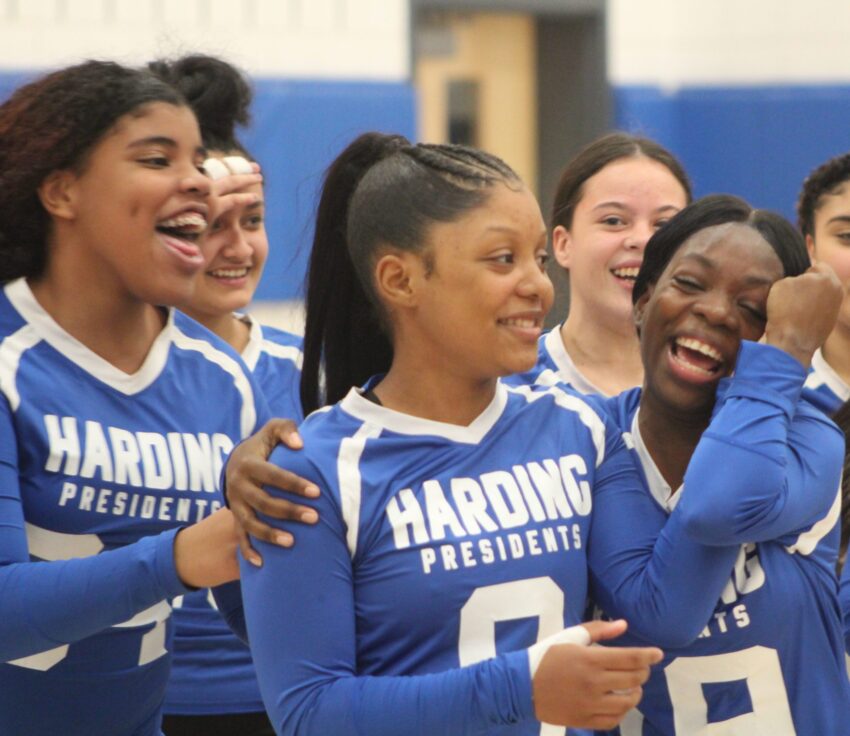
Giving back is kind of our thing. After all, Good Sports was created around the idea that all kids should have the opportunity to play and be active. Because we believe that kids who play do better.
Ensuring youth programs and schools have the proper gear to develop the lives of their kids has always been our goal. Through partnerships with corporations and equipment manufacturers, we’re able to provide brand new sports gear to kids across the country for free. And just like any other nonprofit, we’re here to make life better for those in need.
But what happens next?
Plenty of Netflix documentaries and Sports Illustrated features have told a familiar story: a struggling football team from a struggling high school in a struggling area was given a donation of some kind and good news – it’s all fixed now! This is an age-old tale that usually features one player who gets to live their dream playing football for a D1 college. We always find that out right before the credits roll, right?
But what really happens after the athletes and schools receive Good Sports donations? We’ll do our best to tell you the real story.
In 2018, our first ever short-form documentary premiered. “Problems, Solutions, Heroes” focused on Harding High School of Bridgeport, Connecticut. We saw their tenacity in advocating for student athletes as a perfect example of why gearing up kids in sports is vital. As a society, we already know how sports benefit young people: sports keep them engaged in school, develop healthy lifelong habits and, for many, create a positive outlet that kids truly need. “Problems, Solutions, Heroes” shows the real impact that sports gear can have on an athletic program and the kids it serves.

Photo: Brian A. Pounds / Hearst Connecticut Media
Harding High School sits off of Exit 29 on Route 95 in Bridgeport. One of the oldest port towns in America, you’ll come upon Harding only after you’ve driven past a Bass Pro Shops, an array of so many different family-owned shops that you would think you’re at the UN of groceries, and of course, the bay. Most likely, you’ve rolled up your windows because it’s high tide and that means the air is drenched in a hefty seawater smell.
Home of the Presidents, Harding finished construction in late 2018, costing Bridgeport $107 million[1]. More than 1,100 students started their school year in the city’s East Side under a certificate of temporary residency because construction wasn’t totally done by the time September rolled around. But the longer than expected construction proved to be worth it. Harding High is brimming with modern touches: a cooking classroom, a room for specifically tracking the NYSE, and – of course – brand new athletic facilities.
“We’ve had between thirty and forty D1 coaches come to our games this season alone,” says Eddie Santiago. Both a highly respected teacher and head coach to the Presidents’ football team – and wrestling team – Santiago has seen Harding High School go through massive transitions over the years. Though a Bronx native, Santiago was a Harding High School student himself.
So, why are you here? Why are you in your car trying to not smell the sticky odor of the bay? Everything seems to be in tiptop shape here. There’s a pretty new high school with an exemplary football team. It seems the credits have rolled before you got to this blog. Besides, you’re probably out of high school and way beyond high school sports.
Admittedly, looking back is never easy. It’s like coming home again after being away for a long, long time. Why bother?
“When players make it, we ask them to come back,” Santiago says. “We say no money, no donations. We tell them, ‘Your story is more important.’”
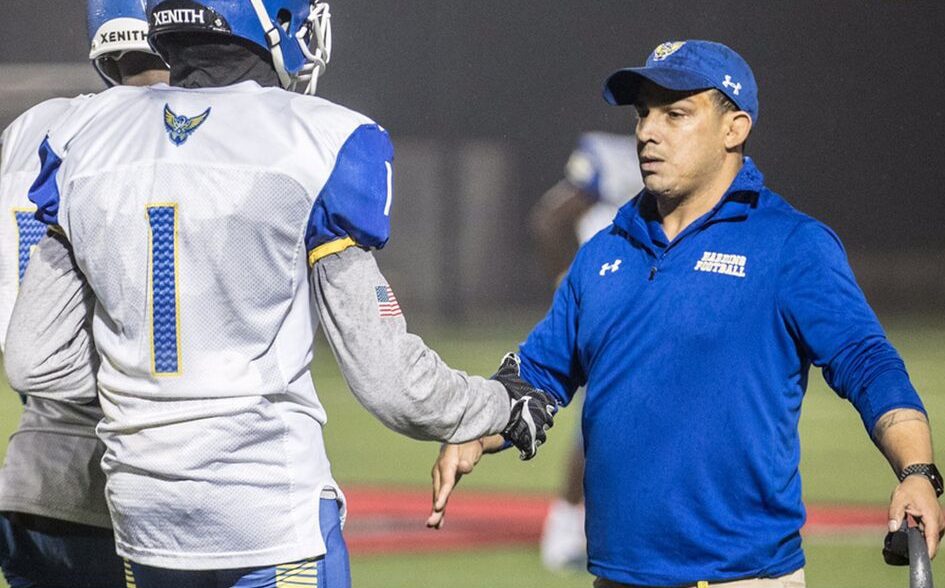
Coach Santiago confers with his players on game night.
Giving back comes in an array of colors. At Good Sports, we do it by donating brand new sports equipment and athletic apparel to youth programs in need. You may do it by adding a small donation when purchasing a cup of coffee. For the kids of Harding High, it’s coming home.
“One of our players came back this summer and hosted a combine for all of the neighboring schools,” Santiago recalls. “I know what these kids go through. To see them thrive and make it…”
If you couldn’t tell, Santiago trailed off right there. Being a coach (and a teacher) is its own sport with special types of distraction. According to Santiago, he averages 12-14 hours a day: six go to teaching and then another six (or so) go to keeping his young men dedicated to the game. And eating right. And finishing their schoolwork.
“And then I go home to my family,” Santiago laughs.
Not that his family is far away. On the other side of the campus, his wife LaDonna Bigelow is coaching not one, but two volleyball games. JV and Varsity girls are strapped into knee pads and sneakers as they wait for her commands. Despite her hitting almost six feet in height, LaDonna could pass for a senior in high school. But then you hear her talk and it’s like experience had a voice all along.
“My job every day is to advocate for these kids,” Bigelow says. In her left hand is a clipboard with rosters that depict the name for every single girl she’s about to coach. “I’ll tell you, the things you hear from these girls. The things that go on in their lives – abuse, trauma – this [sports] is their safe place. And what’s going on at home and the struggles in the classroom; the first person they turn to is their coach.”
And that’s Bigelow. She’s a coach. And a parent. She and Eddie have raised two college students themselves. There’s daughter Jordan, a Harding volleyball alum, who is entering the world of pre-law, and their son Xavier. He is in his second year at Central Connecticut State University on – you guessed it – a football scholarship.
 “Before Good Sports stepped in,” Bigelow recalls, “we didn’t even have enough balls. Our uniforms were discolored and most of the time there weren’t even enough to go around. At a lot of games, our varsity and JV would have to change between games so everyone could play.”
“Before Good Sports stepped in,” Bigelow recalls, “we didn’t even have enough balls. Our uniforms were discolored and most of the time there weren’t even enough to go around. At a lot of games, our varsity and JV would have to change between games so everyone could play.”
Imagine having to peel on a uniform that may not fit, but is definitely drenched in someone else’s sweat. Now imagine getting onto the field knowing your opponent just saw your weakest point: you have no resources. If your games are like that, what are practices like?
“We’re not horrible kids,” she exasperates. “If you come out and see these kids, they’re awesome. They’re just awesome and full of emotion. And they love to win. But to see them grow, those are my wins. I mean, I get texts messages from graduates.”
Will the volleyball alums come back to visit like the football players?
Bigelow nods while briefly checking her roster. She pauses and then calls for a sub on the court. As the exchange is made, Bieglow fires up again: “High five!” The two players laugh, replay their substitution, and make sure they connect their open palms.

“Oh, they’ll come back,” she says, “and it’s starting with Jada.”
As a sophomore, Jada Asbury was a spiker and a blocker for volleyball team. Her freshman year of high school, however, Jada didn’t play anything at all.
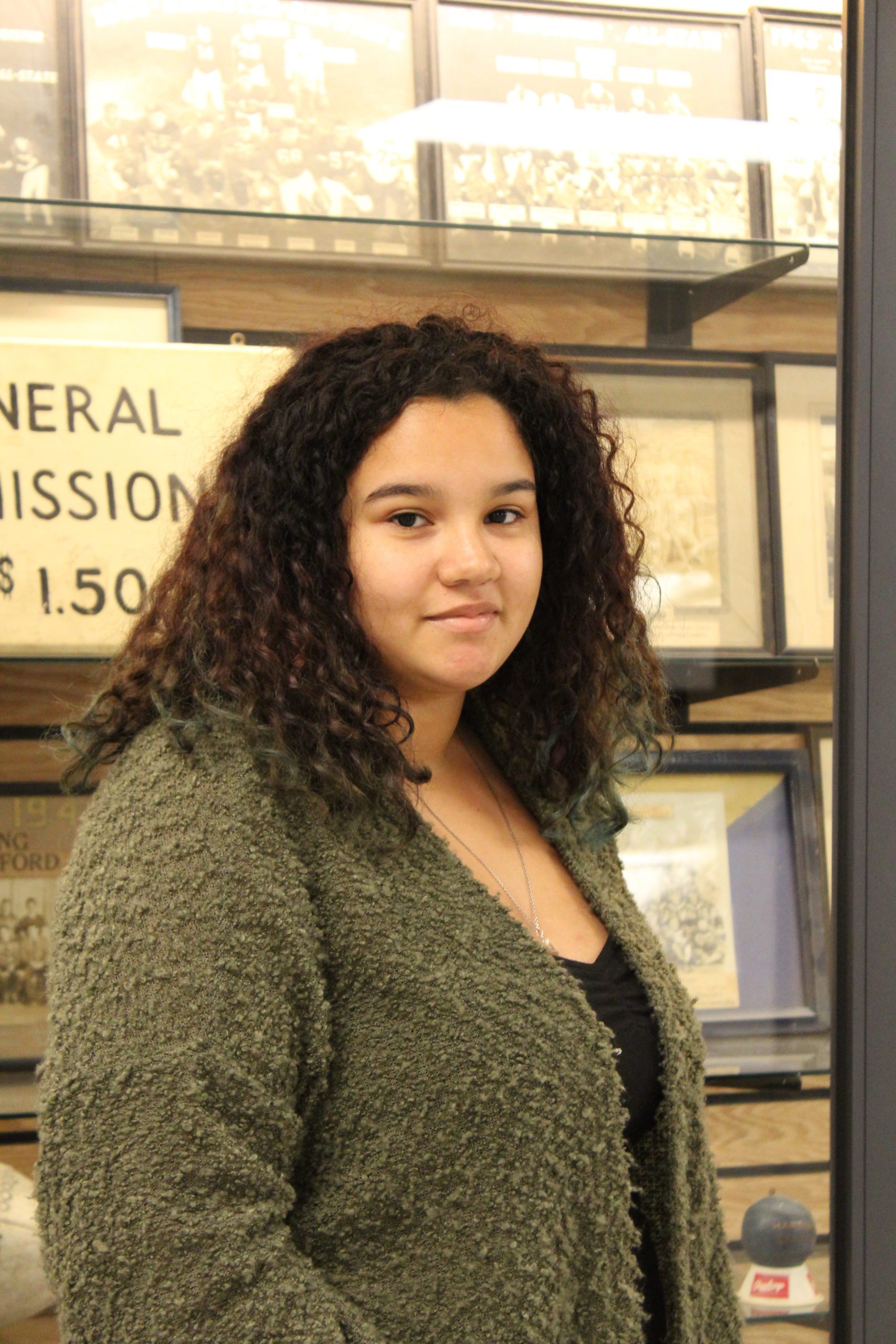
Jada is carrying on the tradition of coaching in her own way by being an advocate in early childcare development.
“I was even a little scared of her in the beginning,” Bigelow laughs. Jada didn’t see it that way, though.
“I played volleyball because Coach made me,” Jada said. “Before I played, I was so stressed out with nowhere to relieve it. I just walked around stressed, but Coach saw something in me. Apparently.”
And, apparently, that’s the story of Jada joining the volleyball team. Goodbye.
Some of us have been recruited by a coach in high school. Maybe they tracked us down because of our size, our height, or how quickly we ran from class to class. Often times, these coaches see something deeper and give us a new reason to get to school on time.
“All of a sudden, it wasn’t just about me anymore,” Jada says. “And I was never alone. It was like having a second family, a second mom. If you couldn’t find your backbone, you had a bunch of teammates behind you who did.”
And a backbone was important playing volleyball for Harding High. Bigelow’s coaching was never over, even if the season was.
“Off-season, she wanted us to be productive. We always had to be somewhere, or she would come for us!”
Her three years playing volleyball under Bigelow gave Jada more than one reason to look back. Now in her second year of college, Jada talks about the typical characteristic playing sports gave her: self-confidence. She’s not afraid to create new groups of friends or try new things. Especially new things that could change her life.
“I just changed my major.”
To what?
“Childcare development. I love working with really small kids, it’s a whole new level of trust where I help them gain skills to grow. And the parents: they’re trusting me, too! Watching people succeed is its own accomplishment; it’s like I succeeded, too.”
It’s these moments where we can see why sports are a vital part of a young person’s ecosystem. The passing down the love for a sport and the skills that come with it is an infectious feeling. After all, Jada is creating her own path so she too can impact the next generation.

However, the sports at Harding High didn’t always come with teary-eyed moments. As with any extracurricular activity, a sports program has its own set of challenges. And of being in an urban setting, the issues usually have to do with finances.
That is, the issue of not having enough.
When the Good Sports documentary about Harding High premiered, we learned that Santiago and his assistant coaches were well versed in empty pockets around school athletics. Even with help from the city, Harding High faced completely losing its wrestling program in 2016. Because of that, personal donations poured in. Then, just like clockwork, it happened again in 2017[2]. Santiago and his coaching staff went back to the donation route.
It took $18,000 dollars to save the wrestling program. For the second time.
“Donations don’t mean money is great,” warns Tyrone Elliot. He’s also part of Santiago’s coaching staff for both football and wrestling. On top of that, he’s the principal for nearby Bridgeport Charter Academy. And on top of that – Elliot is from Stamford and has Harding High in his blood. His uncle was the last All American from the school. Safe to say, Elliot knows school sports.
“The equipment is great,” Elliot continues in reference to the Good Sports donation. “The kids loved it. But our program is still years behind. And there are certain items that would help us coach more effectively. Sometimes, it’s what determines the winners and losers.”
Since the Good Sports donation, the Harding football team has received new helmets, girdles, crash pads, and shoulder pads. Santiago mentioned it enabled their program to focus what finances were available onto things like a food program for players because a full meal at home isn’t an option for every child of Bridgeport.
Sometimes donations can only bring a program out of the red just to break even. It takes a bit more to get into the black.
As the world of youth sports continues to expand in value, the more we continue to see certain groups of kids left behind. As an industry, youth sports is worth $15 billion, according to TIME.[3] And yet, the CDC says less than a quarter of American kids are getting the daily recommended amount of exercise.[4]
It’s easy to find the reason: youth sports has a gap between the “haves” and the “have nots” where those with cash have more opportunities to play. The Aspen Institute found that the kids who are playing sports typically come from families earning a combined income of $90,908.[5]
The average family income in Bridgeport? $44,881. That’s less than both the state and national average.[6]
“We’re advocating for these kids every day, literally,” Elliot says.

As both an educator and a coach, Elliot knows he is advocating for his students and players every single day, summers included.
“It sounds like an exaggeration,” he continues, “but it’s the truth. Because the more active kids you have, the less you have in the street. We try to teach those life lessons. ‘Yes, sir; no, sir.’ We want them to be prepared.”
Elliot talks about how the arrival of new equipment has kept their young men on the field, practicing harder. With up-to-date helmets and enough girdles for all the players, they can develop even more. And safely. It’s opening up more opportunity for each player.

Some of the football team takes a moment to show off their locker room before they take the field for a cold Connecticut night of practice.
“Kids who didn’t think they were college material are beginning to think otherwise,” Elliot says. “After the Good Sports donation, D1 coaches started coming here. And not just to games. These guys are coming to practices. Our kids are beginning to see they have the opportunity to play at the next level.”
Elliot goes on to echo Santiago about what they expect from players that graduate, whether or not they continue to play.
“We only ask that you come and speak to the kids after you. That’s the only thing you owe.”
And that’s exactly what Troy Rainey wants to do. At 6’4, he’s a little short for the average left tackle. But the senior has only relied on his height once to get him where he is now. The rest has been hard work. And pushy coaches.
“When I got to Harding, I really didn’t want to play football,” Troy admits. “But Coach [Santiago] kept coming for me because of my size.”
From being reluctant to even touch a football in 2016, to captain of the Presidents, Troy is officially swatting D1 schools away with a stick. Among others, Baylor, Rutgers, and Bowling Green have come to watch him play. Bowling was so interested, they even showed up for a practice.
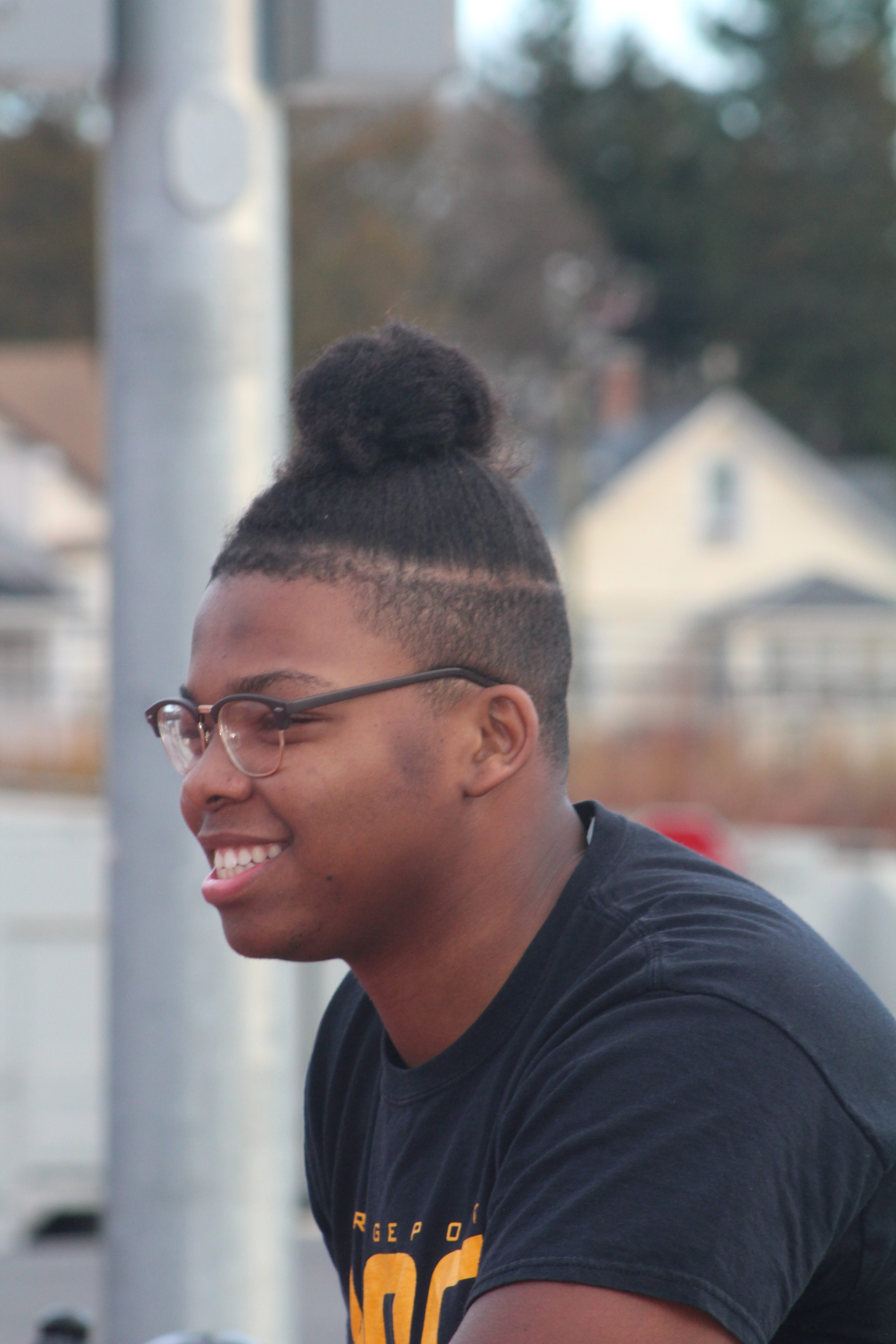
Troy hasn’t even graduated yet and is already planning what his visit back to Harding High will look like.
“The whole atmosphere,” Troy trailed off remembering when Bowling Green came to Harding. “Everyone was so pumped for me. Everyone was on key.”
But Troy was already looking beyond college. Sure, higher education is the immediate next step but Troy is already planning his return to Harding High School. More specifically, he wants to run another combine for his younger football brothers. Even his intended major will him back home.
“I want to study business and real estate,” he says. “I’m interested in helping families around here. It’ll be good to come back.”
The kid hasn’t even left, but he knows what’s important. Just telling his mother he had interest from multiple schools – including scholarship opportunities – was enough to start the water works. Wherever he decides to go, Troy will be the first person in his family to go to college. And there’s a good chance, with new NCAA ruling, that he’ll get paid for it.
“When I come back,” Troy says, “I want to tell people my story. I’ve made a lot of sacrifices. I switched schools, I’ve witnessed death in my family – but here I am.”
Yes, here he is.
And at Harding High, being ‘here’ is held in high regard. Mostly because every teacher, coach, and administrator has been a part of the school for a very long time. For some – actually, most – that stretches back to their childhood.
Superintendent Michael Testani is no different. Having played baseball at Harding, he understands the life lessons sports can teach . But from working in the world of education, he also knows the true cost to putting on an athletic program.
“Before the kids even have uniforms, the costs are already piling up,” he explains. “Refs, busing… Just the cost of officials for football games can be hundreds of dollars.”
Testani isn’t wrong. With some high school refs making close to $100 per game[7] – and having five refs on the field – we’re already talking $500 per game.
“It’s not about becoming a star athlete,” Testani continues. “It’s about building confidence. Especially for our young ladies. It’s great to see participation. The goal is to build their programs where the level of competition can go higher.”
And participation they have. Since the Good Sports donation, Bigelow isn’t having trouble with her volleyball bench. It’s full. There are enough balls for each girl.

Superintendent Testani knows the challenges Bridgeport as a whole has overcome to provide athletics to its students.
“We lent some to Bassick tonight,” she nods towards the opposing bench. Two girls from Bassick High wave back. They have gift bags in their hands.
While the football team has a steady tradition of boys coming back to teach the younger ones, the volleyball teams have a well-rounded Senior Night. And the opposing team is a part of that.
Bigelow watches as her senior girls come off the court for a final time. The buzzer competes with the cheers from parents, friends, and teammates. Harding won their final game, but the night isn’t over. Someone gives Bigelow a mic and once everyone realizes this, the room becomes dead quiet. While scattered throughout different points in the gym, not one person is talking. Clearly, Coach LaDonna Bigelow is in charge.
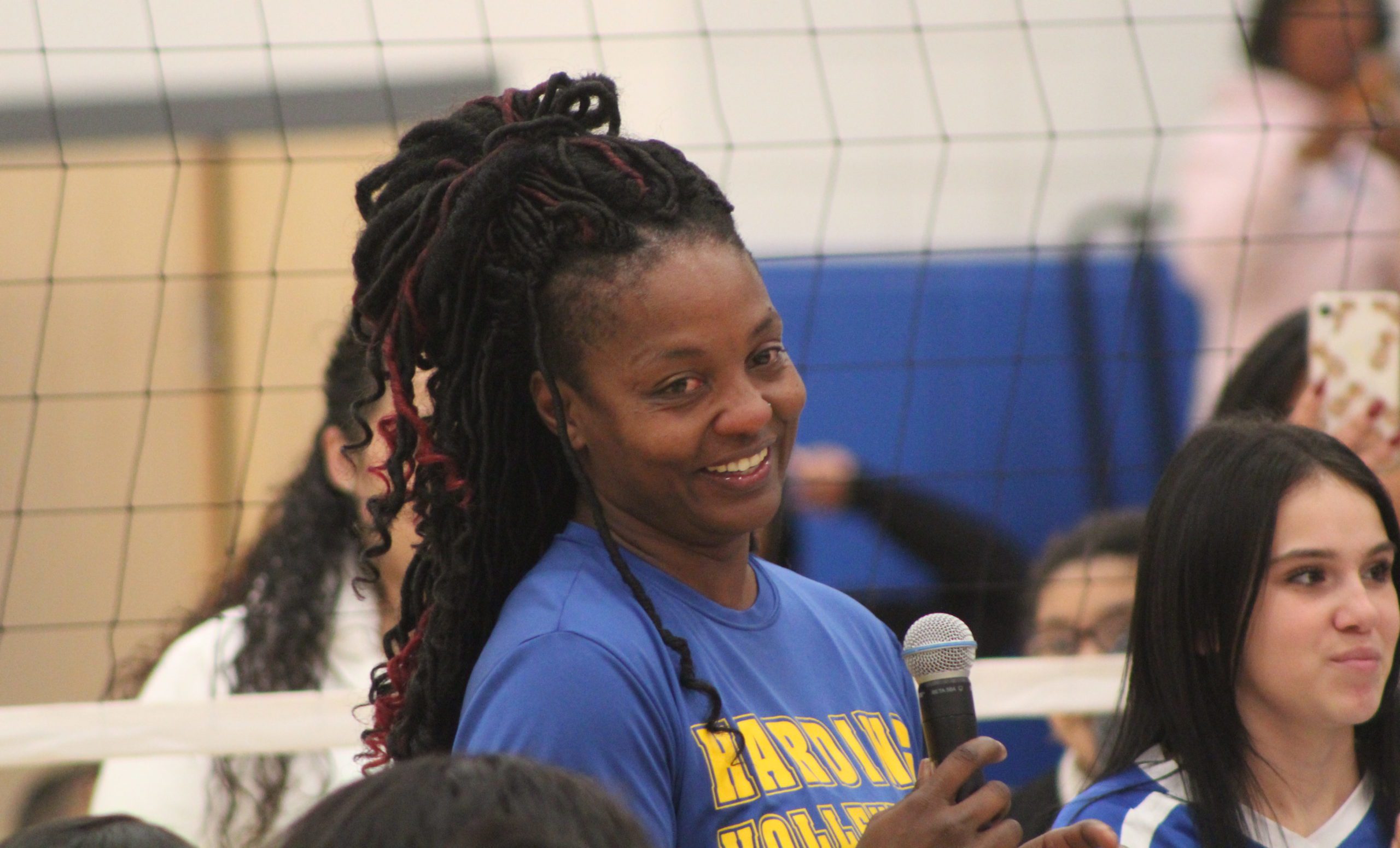
Coach Bigelow announces gratitude for both her players and those from the other school.
“Parents,” she starts with a slight shake in her voice, “thank you for trusting me with your most prized possessions. These girls have worked so hard and we just want to make sure that each and every one of them knows that.”
She begins to call up the seniors, one by one, announcing their names, their position, and a small story about them. Every anecdote gets a laugh, and a few tears over smiling cheeks. Each player gets a small gift to exchange with a girl from Bassick that shares her position. Literally, the two schools are celebrating their seniors together. At the same time.
Finally, the two teams mingle into one last cheer. Looking like a discolored candy cane with their clashing uniforms – Harding blue and Bassick green – the girls cheer each other on. Some of them will go onto college in the fall of 2020, some will start their careers, others will take time working the jobs they already have. But, in that moment, they are all athletes. Just kids who love to play.

Remember how we promised we would tell you the real story? And how we’d avoid the same old one you hear time and time again in high school sports? You know the one. We have to break our promise.
Troy Rainey officially committed to playing football for Rutgers University.